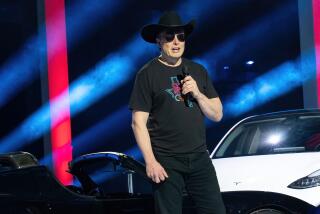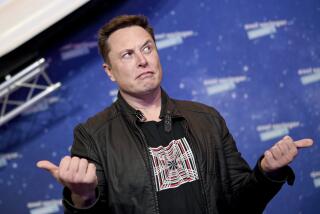Visionary Elon Musk is forced to focus on the mundane to keep his Tesla dream alive
Elon Musk set out to build a different kind of car company. He succeeded.
Now he’s dealing with the consequences.
As became clear over the past week and a half, the man whose mission is to help save Earth for humanity through sustainable transportation and energy — and colonize Mars as a backstop in case that doesn’t work — is being forced to focus on goals that are far more mundane, like building high-quality affordable cars and creating an efficient sales, parts and service system.
“Elon has to deal with reality,” said Ross Gerber, a Tesla investor and hardcore Musk fan at the Santa Monica investment firm Gerber Kawasaki.
Musk emailed a note to employees Friday that plunged Tesla’s stock price 13% and wiped out $7.7 billion in market value.
In the email, Musk pointed out that 2018 was the most successful year in Tesla’s history. The company delivered almost as many cars in the last quarter as it did in all prior years combined since Tesla’s founding in 2003.
“Model 3 also became the best-selling premium vehicle of 2018 in the US,” he wrote. “This is truly remarkable and something that few thought possible just a short time ago.”
All true. Musk has chalked up some astounding accomplishments. The Model S blew the industry away with its performance, battery range, over-the-air software updates and elegant body design. The Model 3 has drawn rave reviews for its tight, fast, fun drive.
Musk understands what serious drivers love about cars and, in perhaps his most masterful achievement, made driving an electric car cool, even sexy, rather than the domain of dorks.
But despite Tesla’s growth, it’s fallen far short of what Musk had been projecting, forecasts that shot the stock price so high it exceeded General Motors in market value, based on expectations of dramatic growth.
Musk’s email talked less about growth and more about what’s needed to survive. He told Tesla’s 37,500 employees that 7% of them — around 2,500 — would lose their jobs. (Tesla laid off 9% of its workers last June, when Musk told employees, “We are making this hard decision now so that we never have to do this again.”)
Another Musk company got hit with layoffs on Jan. 11. SpaceX, the private rocket ship company, announced plans to lay off around 10% of its more than 6,000 employees.
In a statement released at the time, the Hawthorne company said it needed to become “leaner” to continue delivering for its launch customers, as well as to succeed in its ambitious plans of developing Mars spacecraft and thousands of small satellites that would provide internet service to users on Earth.
“Either of these developments, even when attempted separately, have bankrupted other organizations,” SpaceX said in its statement.
At Tesla, Elon Musk set out to revolutionize manufacturing.
He didn’t.
The sophisticated robot system that Musk told analysts in 2016 would spark “a quantum change in productivity” was ripped out last year. The company is turning out less than half the cars Musk once promised — some from a tent — and those cars can be found at or near the bottom of independent quality rankings.
Musk also aimed to upend traditional sales, parts and service and steer clear of franchised car dealerships by running its own retail and repair operations. The result is a high-cost customer-service nightmare, as Tesla owners spend hours trying to arrange to have their cars fixed and then have to wait weeks or months for parts.
Meantime, the $35,000 mass-market Model 3, which Musk began hyping more than three years ago, remains a mirage, as luxury-price Model 3s approach the limits of customer demand.
None of Tesla’s cars right now is priced for a middle-income buyer.
The base Model 3 currently is $44,000. Typical customers pay around $60,000 after adding options. A high-end Model 3 goes for $70,500.
The Model S sedan starts at $82,250 and runs as high as $145,000. The Model X SUV, $85,000 to $147,000. At those prices, it’s no surprise high-margin S and X sales have reached a limit of about 100,000 cars a year.
Federal incentives on Tesla cars got chopped in half in January to $3,750, will be cut in half again in July and disappear at year’s end.
So Tesla must contend, belatedly, with an inevitable shift from the days when it could focus on a narrow, obsessed band of high-income luxury buyers excited about over-the-air software updates to one where it has to worry about squeezing nickels out of the cost of a mass-market product for a middle-class clientele, while providing timely repairs of fenders and windshields to 400,000 car owners.
In other words, Tesla must act more like traditional car companies that have continuously improved basic logistics and manufacturing processes over the past 100 years.
The upcoming layoffs will reduce costs to help Tesla produce a profitable $35,000 Model 3, Musk said in his Friday email.
“We need to reach more customers who can afford our vehicles,” Musk wrote. “We need to continue making progress towards lower priced variants of Model 3.”
Engineering improvement on the manufacturing line also will be needed to boost throughput and cut thousands of dollars off the cost of each Model 3 to make the cars more affordable, Musk said.
To make these and other fixes, Tesla had nearly $3 billion in cash at the end of the third quarter. Fourth-quarter results, including cash on hand, will be released probably next month.
Analyst Jessica Caldwell at auto-pricing site Edmunds.com told clients Friday: “It’s refreshing to see Elon Musk announcing practical, traditional steps to get Tesla ready for what could be the company’s most challenging year yet.”
“When you’re talking about a company that builds tents to solve production challenges, it’s almost more notable when you see them doing something conventional,” she said.
You’d think other projects would be sidelined while Tesla fixes current problems, but Musk nonetheless pumped his dreams for the future at the end of his employee email: “Full self-driving, Model Y, Semi, Truck and Roadster on the vehicle side and Powerwall/pack and Solar Roof on the energy side are only the start,” he said.
But employees are being laid off at the Buffalo, N.Y., site where the tiles for the solar roof are being made. (Musk unveiled the solar roof tile project at Universal Studios in 2016 weeks before Tesla bought SolarCity, whose board Musk chaired and in which he was a big investor. The tiles Musk showed off, Fast Company revealed, were non-functional.) Employees are being laid off at Tesla sales and service centers as well, putting more pressure on an already overburdened system.
Some longtime supporters are growing frustrated with the company. Kim, the hyper-chipper star of the “Like Tesla” YouTube channel, posted a critical video last week. “I am one of Tesla’s biggest superfans, but I also feel like I can’t let my love for them cloud my judgment,” she said. “Tesla customer service kind of sucks right now.” She beseeched the company to spend more on service operations to deal with its “growing pains.”
Gali, another superfan, said on his “Hyper Change” YouTube channel that “Tesla’s culture is chickens running around with their heads cut off. It’s a company that’s growing like crazy, they try to do so many things at once.”
Investor Gerber says he believes, too, that Tesla’s problems reflect growing pains.
“Tesla’s not going anywhere. They’re not going bankrupt,” he said. Musk’s email is a “good sign” he’s ready to do what’s needed to maintain Tesla growth, Gerber said. “It’s a sign that he’s in a better place mentally.”
Times staff writer Samantha Masunaga contributed to this report.
Twitter: @russ1mitchell







